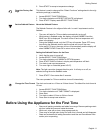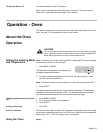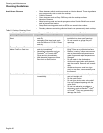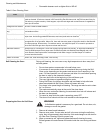
Getting the Most Out of Your Appliance
English 18
• Dark, rough or dull pans will absorb heat resulting in browner, crisper crust.
Some manufacturers recommend reducing temperature 25° F when using
these pans. Follow manufacturer recommendations.
• Use glass or dark metal pans for pies.
• Insulated baking pans may increase the recommended baking time.
Preheating the Oven Preheat the oven if the recipe recommends it. Preheating is necessary for good
results when baking cakes, cookies, pastry and breads. Setting a higher tempera-
ture does not shorten preheat time. Place oven racks in proper position before
preheating. A beep will confirm that oven is preheated and selected oven temper-
ature will be displayed.
Oven Cooking Modes
Bake, Proof and Warm
Baking is cooking with dry, heated air. The lower
burner cycles to maintain the oven temperature.
Bake mode can be used to prepare foods like
pastries and casseroles as well as to roast
meats.
When proofing, the oven will use the upper and
lower element to maintain a low temperature to
proof bread.
• Proofing is the rising of a yeast dough.
• The Proofing temperature is 100° F.
• Loosely cover the bowl or pan and use any rack that accommodates the size
of the container.
• Keep the door closed and use the oven light to check the rising of the dough.
When warming, the upper and lower elements maintain a low temperature in the
oven cavity in order to keep food at serving temperature. There are two warming
levels: WARM HIGH and WARM LOW.
• Use the Warming setting on the oven to keep foods hot until ready to serve.
• WARM HIGH is 190° F and WARM LOW is 150° F.
• Foods that must be kept moist should be covered with a lid or aluminum foil.
CAUTION
When using Warm mode, follow these guidelines:
• Do not use the Warm Mode to heat cold food.
• Be sure to maintain proper food temperature. The USDA recommends hold-
ing hot food at 140°F or warmer.
• DO NOT warm food for longer than one hour.
Broil
Broiling uses intense heat radiated from the
upper burner. The Broil mode is best suited to
cooking thin, tender cuts of meat (1” or less),
poultry and fish. It can also be used to brown
breads and casseroles. Always broil with the
door closed.
The benefits of Broiling include:
• Fast and efficient cooking
• Cooking without the addition of fats or liquids
• Browning as the food cooks


















